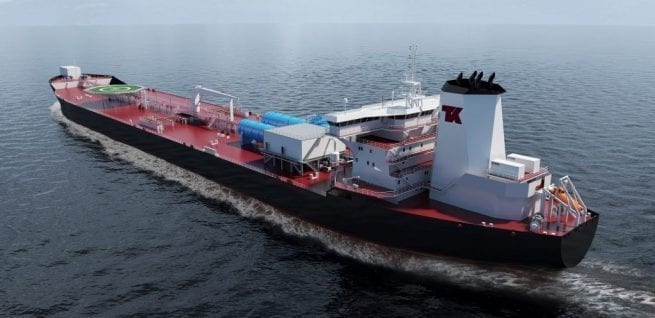Company News
OPRA Turbines Setting New Standards For Both Fuel Consumption And Greenhouse Gas Emissions

Stop Venting, Start Saving!
The combustion technology of the OP16 Gas Turbine addresses the challenging emissions requirement in the marine industry and the need for low emissions technology for ships for emission-controlled areas (ECAs). The NOx and CO emissions can be kept well below 5g/kWh while operating on natural gas fuel adhering to the IMO Tier III emission compliant guidelines. This is achieved without requirement of abatement systems like SCR. This makes OP16 Gas Turbines IMO Tier III compliant and ready engines. Apart from this, OP16 Gas Turbines have significantly lower CO2 emissions compared to reciprocating engines.
Volatile Organic Compounds (VOCs), except methane, are called NMVOCs that evaporate from crude oil due to their volatile characteristics. Storage, loading and unloading of oil in offshore platforms, storage ships (FSOs and FPSOs), onshore storage tanks and terminals, and on shuttle tankers, contribute significant emissions of NMVOCs. These VOCs are a mix of heavy hydrocarbons too volatile to be burnt in reciprocating engines. Apart from being volatile, the VOCs have a very low calorific value and change in composition during a short span of time which cannot be accepted by traditional axial gas turbines and reciprocating engines. This results in venting of VOCs or inefficient VOC combustion contributing to the GHGs and VOC emissions.
100% VOC Recovery From Shuttle Tankers
OPRA gas turbines recover 100% VOC emissions from shuttle tankers, combusting surplus methane gas from VOC plant of approximately 10 ton per loading. Emissions are reduced from 27,000 tons CO2 to less than 1,000 tons CO2annually, while also providing electric power to the vessel grid. As OP16 Gas Turbines are fuel flexible with dual fuel capabilities they can operate on VOCs and natural gas simultaneously, ensuring continuous power in case of VOC supply shortage and can be used as a combined emergency and standby power supply system on board ships.
High Performance Under All Site Conditions – Marine Gas Turbine
The OP16-3C Gas Turbine can run on VOCs from shuttle tankers or boiloff gases from LNG tanks in gas carriers, that are generated during the transportation, loading and unloading. The radial design of the OP16 Gas Turbine, along with the 3C combustion system, is designed to run on unconventional and low energy content fuels like VOCs and boiloff gases, that are otherwise vented or flared. As VOC generation is not constant and rather intermittent, the power generated from the OP16 Gas Turbine can be fed into the battery system of the shuttle tanker. This stored power can be made available to the main switchboard of the ship. The battery packs can also be used for blackout prevention and peak shaving.
This gas turbine based solution is a compact, lightweight, low maintenance, and vibration-free power system that can replace existing engines or boilers which are large and heavy, with high vibration and demanding frequent maintenance. The OP16 Gas Turbine is an air-cooled machine and can easily be installed in the superstructure of ships, isolated from the engine room, and eliminating the need for cooling water system piping in engines. This arrangement ensures emergency power supply in a catastrophic event of water flooding of engine room.
Delivering World-Class Technology
With minimal servicing and downtime periods required, the OP16 Gas Turbine is a reliable source of power on board. A high rotational speed of 26,000 rpm ensures a virtually vibration-free machine. Requiring an annual inspection only after 8,500 hours and a major overhaul after 40,000 hours of operation, the OP16 Gas Turbine provides high availability to ship operators.
The OP16 Gas Turbine All Radial Design Has Unique Benefits!
The OP16 Gas Turbine, powered by a single-shaft, all-radial turbine, can be configured to specifically meet the requirements of marine applications and operate as an auxiliary drive on board. Its compact design is achieved by using a single-stage, one-piece centrifugal compressor and a single-stage radial turbine, making it well suited to commercial, naval ships and FPSOs as constrained space requirement and reliability are of utmost importance. The all-radial design of the OP16 Gas Turbine enables a high power-to-weight ratio machine; delivering power with a smaller footprint.
Having a cantilevered design results in only one lubrication bearing, placed in the cold end of the turbine, allowing longer bearing life with minimum oil consumption and a guaranteed oil-free exhaust. Special alloys are used for the compressor impeller and turbine wheel making them resistant to the corrosive marine environment and salty ambient air.
The OP16 Gas Turbine all radial design allows for dual fuel operation on a wide range of fuels, as well as creating a self-cooling process of the turbine blades, eliminating the need for cooling holes on the turbine blades. This ensures the OP16 Gas Turbine is highly resistant to foreign object damage and avoids the combustion deposit build-up that could easily constrict the flow path of an axial turbine or corrode the moving parts in a reciprocating engine.
Driving The World’s Energy Transition
As a leading developer and manufacturer of advanced gas turbine based generator sets in the 1.8 MW power range OPRA presents a unique and efficient power generation solution to shuttle tanker operators with the OP16 Gas Turbine, which adheres to the IMO Tier III emission compliant guideline. Setting the standard in terms of availability, reliability and low maintenance costs, OP16 Gas Turbines allow for very cost-effective ‘always-on’ generation of electricity and heat. The capability of the OP16 Gas Turbine to run on a wide range of liquid and gaseous fuels like MDO, MGO, LNG, and VOCs from Oil tankers, makes a perfect fit for new generation of energy-efficient and environmentally friendly ships.
